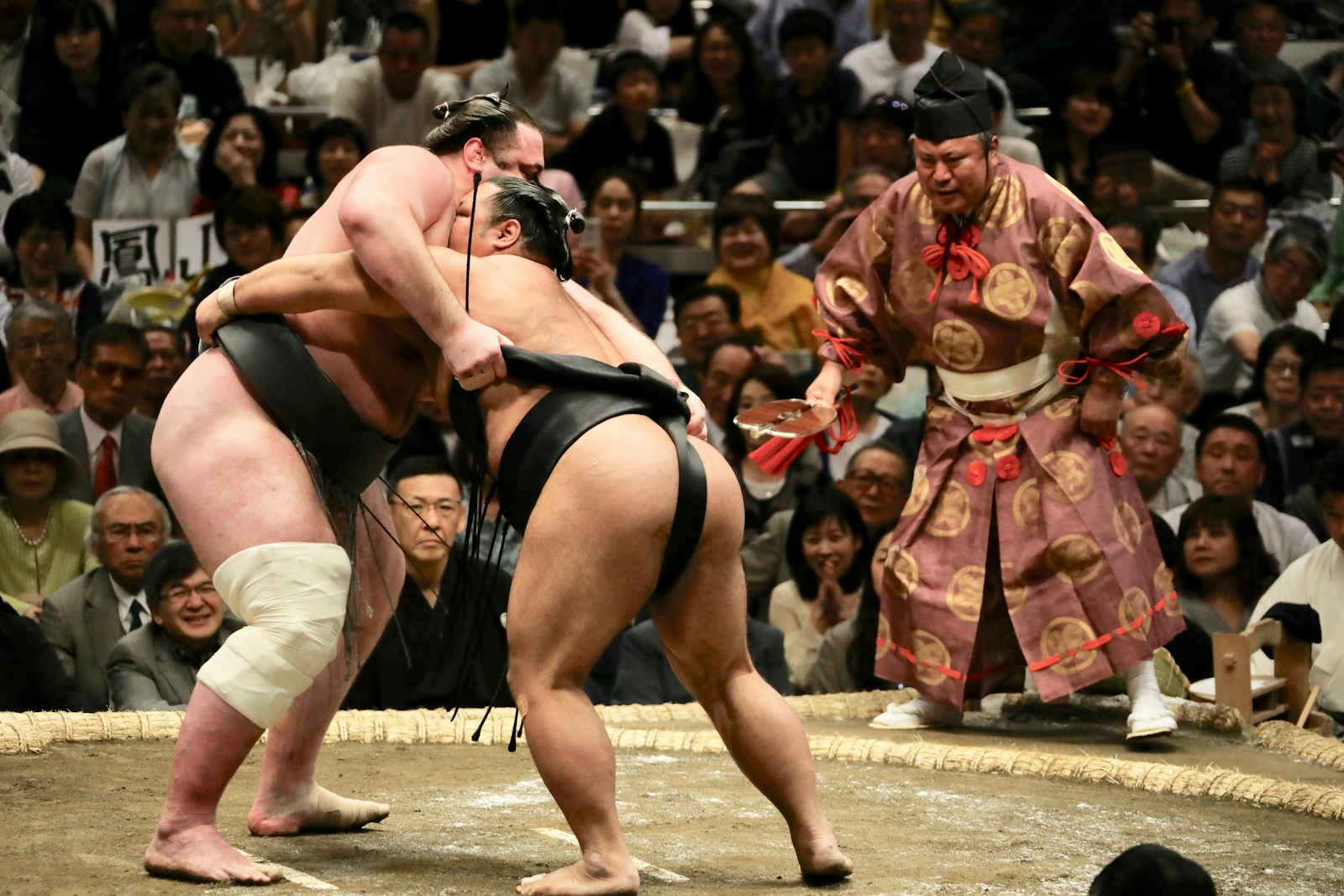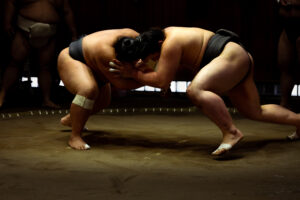Sumo wrestling, Japan’s national sport, is a spectacle of power, tradition, and ceremony. This ancient form of wrestling, deeply embedded in Shinto rituals, offers a fascinating glimpse into Japan’s cultural heritage. It’s a world where giants clash in the ring, adhering to centuries-old customs and showcasing a unique blend of strength, agility, and strategy. As sumo wrestling continues to capture the imagination of people around the world, let’s delve into the heart of this giant sport, uncovering its rituals, the life of its wrestlers, and its evolving future.
Sumo Wrestling: Japan’s Traditional Titan Clash
Sumo wrestling, with its roots stretching back over a thousand years, stands as a testament to Japan’s rich history and cultural legacy. It’s more than a sport; it’s a living tradition that enshrines the values and spirit of the nation. In the sumo ring, or dohyo, wrestlers known as rikishi clash in bouts that, while often brief, are intense displays of power and technique. These matches are not merely contests of strength; they are steeped in ritual, with every action from the stomp of a foot to the slap of flesh echoing centuries of tradition. The sport’s grand tournaments, held six times a year, draw crowds from across Japan and around the world, captivated by the spectacle and drama of sumo’s titan clashes.
Inside the Dohyo: The Sacred Battle Ring
The dohyo, sumo’s battle ring, is a sacred space. Constructed from clay and sand, it is ritually purified with salt before each tournament, reflecting sumo’s deep connections to Shinto beliefs. The ring, measuring 4.55 meters in diameter, is not just the physical arena for the wrestlers; it symbolizes the universe, with the match representing the eternal struggle between forces. Four tassels, each one representing a season, hang from the roof over the dohyo, further embedding the sport within the cycles of nature. The construction and dismantling of the dohyo for each tournament are ceremonial, underscoring the respect sumo pays to its spiritual and cultural foundations.
A Day in the Life of a Sumo Wrestler
Life as a sumo wrestler, or rikishi, is one of discipline, communal living, and rigorous training. Wrestlers reside in sumo stables, where every aspect of their daily routine—from their diet to their training and even their rest—is meticulously managed. The day begins early, with training sessions starting before dawn and lasting several hours. These sessions are intense and demanding, designed to build strength, flexibility, and technique. Afternoons are for rest and chores, while evenings are dedicated to communal meals, where the rikishi consume large quantities of a high-calorie stew known as chanko-nabe, the cornerstone of their weight-gaining diet. The hierarchical nature of sumo culture is ever-present, with younger wrestlers serving their seniors, echoing the respect and order that define the sport.
The Rituals and Ceremonies of Sumo Explained
Sumo wrestling is imbued with rituals and ceremonies that trace back to its Shinto origins. Before a match, wrestlers engage in a series of symbolic actions: throwing salt to purify the ring, the ceremonial stomping to drive away evil spirits, and the lifting of their legs and clapping, a gesture meant to attract the attention of the gods. Each bout begins with a stare-down, an intense psychological battle before the physical clash. The rituals extend beyond the matches themselves, encompassing the sport as a whole, from the ritualistic creation of the dohyo to the elaborate hairstyle of the rikishi, which is reminiscent of the samurai chonmage.
Training Giants: The Rigorous Sumo Regimen
Sumo wrestlers undergo a grueling training regimen that builds not only their remarkable size but their agility and technique as well. The cornerstone of their training is the keiko, a practice session that includes a series of drills and sparring matches. These sessions are exhaustive, pushing the wrestlers to their limits to improve their skills and endurance. Strength training is complemented by flexibility exercises, ensuring that wrestlers can move quickly and efficiently despite their size. The demanding nature of sumo training is a crucible, shaping the rikishi into athletes capable of withstanding the intense, physical battles in the dohyo.
The Hierarchy of Sumo: Understanding the Divisions
Sumo’s organizational structure is a complex hierarchy, with wrestlers ranked in a system that dates back centuries. The top division, known as the Makuuchi, is where the sport’s stars compete, including the Yokozuna, sumo’s highest rank. Below the Makuuchi are the Juryo, Makushita, Sandanme, Jonidan, and Jonokuchi divisions, each representing different levels of skill and experience. Wrestlers’ ranks are determined by their performance in tournaments, with the goal of every rikishi being to ascend through the ranks to reach the esteemed position of Yokozuna. This hierarchical system adds a layer of strategy to the sport, as wrestlers not only battle for victory in the ring but for advancement within the sumo world.
Sumo Stables: Where Champions Are Forged
Sumo stables, or heya, are the heart of the sumo world. These training houses are where wrestlers live, train, and learn the ways of sumo. Each stable is run by a stablemaster, usually a retired wrestler, who oversees the training and care of the rikishi. The communal lifestyle within the stables fosters a sense of brotherhood and discipline, crucial components of a wrestler’s development. Stables are not just training centers; they are repositories of sumo’s traditions, where the ancient rituals and techniques of the sport are passed down from one generation to the next.
The Diet of a Sumo Wrestler: Size and Strength
The diet of a sumo wrestler is designed to build mass without sacrificing agility. Central to their diet is chanko-nabe, a nutrient-rich stew filled with meat, fish, and vegetables, consumed in vast quantities to promote weight gain. However, their diet is balanced with rice, noodles, and other dishes, ensuring that wrestlers receive a comprehensive intake of carbohydrates, protein, and fats. This high-calorie diet is complemented by a rigorous training regimen, allowing wrestlers to convert the bulk of their size into muscle, essential for success in the ring.
Women in Sumo: Breaking the Sacred Barrier
Sumo wrestling has traditionally been an all-male sport, deeply rooted in Shinto rituals that have historically excluded women from the dohyo. However, in recent years, there has been a growing movement to challenge these traditions. Female sumo wrestling, while not officially recognized by the professional sumo association, has been gaining popularity, with women’s clubs and amateur competitions emerging both in Japan and internationally. These developments signify a slow but steady shift in attitudes, as women seek to break the sacred barrier and earn their place in the world of sumo.
International Sumo: The Sport Crosses Borders
Sumo wrestling is no longer confined to Japan; it has become a global phenomenon. With the rise of international competitors and the popularity of sumo clubs and amateur tournaments worldwide, the sport is reaching a broader audience than ever before. This international exposure has introduced sumo to diverse cultures, leading to an exchange of ideas and techniques that enrich the sport. As sumo continues to cross borders, it faces the challenge of balancing tradition with the demands of a global audience, striving to remain true to its roots while embracing its growing international appeal.
The Future of Sumo Wrestling: Evolution and Challenges
The future of sumo wrestling is a blend of tradition and adaptation. As the sport confronts challenges such as declining domestic interest and the pressures of modernization, it is also finding new avenues for growth and evolution. Innovations in training, diet, and even the integration of technology in training methods are shaping a new era for sumo. Moreover, the increasing visibility of women in sumo and the sport’s international expansion are opening up new dialogues and opportunities. Despite these changes, the heart of sumo remains unchanged: a test of strength, spirit, and tradition.
Sumo’s Greatest Legends: Giants of the Ring
Sumo wrestling has produced many legends, wrestlers who have transcended the sport to become cultural icons. These giants of the ring, such as Hakuho, Taiho, Chiyonofuji, and Takanohana, are revered not just for their prowess in the dohyo but for their embodiment of sumo’s enduring values. Each legend has left an indelible mark on the sport, setting records, inspiring future generations, and contributing to the rich tapestry of sumo’s history. The stories of these sumo greats are a testament to the sport’s lasting legacy and its capacity to capture the imagination of fans around the world.
Sumo wrestling, a giant sport in both stature and spirit, continues to fascinate and inspire. From the sacred sands of the dohyo to the rigorous lives of its wrestlers, sumo is a living tradition that encapsulates the heart of Japan. As the sport evolves, facing modern challenges and embracing new opportunities, it remains anchored by its ancient rituals and values. Sumo wrestling, with its blend of strength, skill, and ceremony, stands as a testament to the enduring appeal of Japan’s traditional titan clash.








